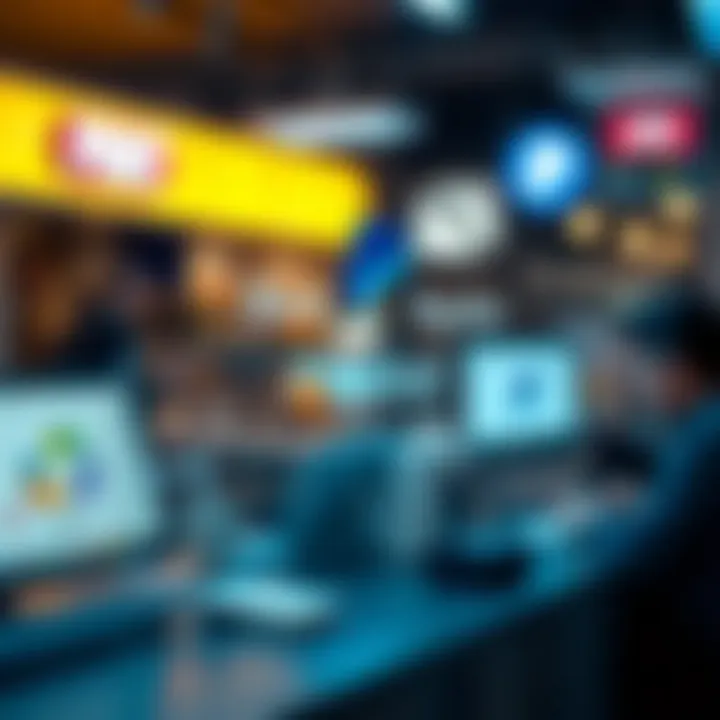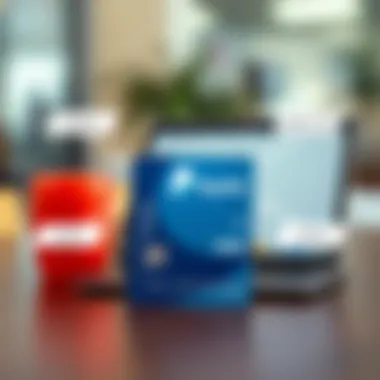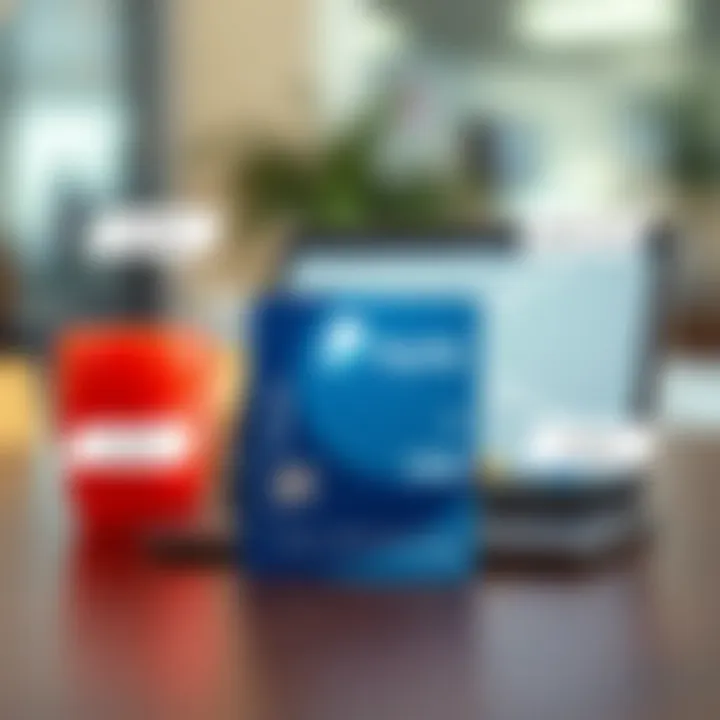Using PayPal Without a Bank Account: Practical Options


Intro
In the digital age, financial transactions have been transformed, with platforms like PayPal leading the charge. But what happens if you're not tethered to a traditional bank account? This can be quite the pickle, especially for those navigating their finances without the safety net of conventional banking. In this article, we'll dive deep into various ways to access PayPal without needing a bank account. This exploration uncovers prepaid options, debit cards, and some inventive financial alternatives that can help individuals manage their money fluidly.
Key Definitions
Essential Financial Terms
Understanding the jargon is crucial when traversing financial waters. Here are a few key concepts:
- PayPal: A widely-used online payment system that allows individuals and businesses to send and receive money electronically.
- Prepaid Card: A payment card that is preloaded with a specific amount of money, usable until the funds are depleted.
- E-wallet: A digital application that stores payment information for various payment methods. It can be linked to accounts but doesn't require a traditional bank.
- Third-party services: Financial services that aren't directly connected to traditional banking, offering alternative ways to manage funds.
Terminology Breakdown
It's also helpful to break down some specific terms associated with using PayPal without a bank:
- Transaction Fees: Costs that may be incurred for processing payments or sending money.
- Account Linking: The process of connecting a bank account or card to your PayPal account for additional features.
- Cash Load: Adding cash to a prepaid card, sometimes available at retail locations or service providers.
Understanding these terms will help demystify the process of accessing and utilizing PayPal without relying on bank accounts. Each method explored in this article is tied to these foundational concepts.
"Navigating financial services without a bank requires creativity and understanding of alternative options."
Armed with this knowledge, we can now venture into the various methods that allow access to PayPal without needing a bank account.
Preface to PayPal and Financial Independence
In recent years, financial independence has taken on new meanings, especially with the rise of digital payment systems like PayPal. This platform has opened doors for individuals who wish to manage their finances without a conventional bank account. For many, the traditional bank setup feels overly complicated or inaccessible. Using PayPal, people can conduct transactions and engage in commerce without being tied to a specific bank.
The importance of understanding how to navigate PayPal independently goes beyond mere convenience. It offers users a chance to gain more control over their economic lives. PayPal is not just an online wallet; it’s a tool that can bolster one's financial flexibility, allowing users to send and receive money, shop online, and even process payments for goods or services—all with relative ease.
With this financial tool, one can bypass some hurdles that come with traditional banking: lengthy paperwork, minimum balance requirements, and sometimes the need for a credit check. Instead, PayPal allows a range of alternatives for those wishing to steer clear of banks, thus empowering individuals to make their own financial choices. This autonomy can help foster a sense of financial security and independence.
However, it’s not all sunshine and roses. Understanding the mechanics of PayPal also brings in certain considerations. Transaction fees can add up, and there are limits on how much can be transferred without linking a bank account. Therefore, being educated about the specific features of PayPal is crucial for anyone looking to utilize its services effectively.
Additionally, users must remain vigilant about the security of their accounts. When financial independence is at stake, safeguarding personal information becomes paramount. Ultimately, this article will delve into various strategies and financial alternatives available to access PayPal without needing a bank account.
"Financial freedom is available to those who learn about it and work for it."
In summary, understanding PayPal and its alternatives provides a path toward greater financial autonomy and capability. Whether you are a seasoned investor, a small business owner, or simply someone wanting more control over your funds, tapping into the world of digital wallets can be a liberating experience.
Understanding PayPal's Operations
Understanding how PayPal operates is essential for anyone looking to navigate its features without a bank account. Since PayPal has become such a staple in online transactions, grasping its inner workings can unlock a world of financial possibilities. Here, we'll explore the fundamental aspects of PayPal, how it was created, and what makes it tick. This knowledge lays a solid groundwork for those interested in utilizing PayPal’s services efficiently without traditional banking.
What Is PayPal?
PayPal is a digital payment platform that allows users to send and receive money across the globe. Founded in December 1998, it quickly rose to prominence in the e-commerce world due to its convenience and reliability.
- PayPal serves as a middleman in transactions, providing an extra layer of security. This is especially beneficial for those who are cautious about direct bank transfers or sharing sensitive financial information online.
- The platform supports various payment methods, including credit and debit cards, direct bank transfers, and PayPal's own balance system. This flexibility appeals to users from diverse financial backgrounds.
- Furthermore, PayPal integrates with numerous online retailers, making it a go-to choice for consumers shopping online, as it provides comfort in knowing transactions are protected. Essentially, it enables seamless transactions without the need for physical cash.
How PayPal Functions Without a Bank Account
For individuals who prefer or need to operate without a traditional bank account, PayPal offers several alternatives, ensuring that access to crucial financial services is maintained. Understanding these functions can empower users to make the most of PayPal’s features while circumventing the need for a bank. Here are some key ways PayPal can function without a direct link to a banking institution:
- Prepaid Cards: They are linked directly to your PayPal account, allowing you to load funds and spend online without requiring a bank account. These cards are generally available through retail outlets, and can be loaded with cash, providing flexibility for users.
- Cash Funding Options: Users can deposit cash into their PayPal accounts through partner retailers. This method is particularly useful for those who prefer to handle transactions in physical currency.
- Sending and Receiving Money: Individuals can receive funds from others through PayPal and utilize that balance for their payments, completely bypassing the necessity of a bank account.
In a nutshell, understanding these operational mechanics arms users with the knowledge necessary to navigate PayPal effectively, opening doors to alternative financial pathways that blend seamlessly with the digital age.
Receiving Money on PayPal Without a Bank


Navigating the world of online transactions often raises questions, particularly when it comes to receiving funds without relying on traditional banking. The ability to receive money on PayPal without a bank account is not merely a convenience; it opens doors to financial inclusivity for those who might feel cut off from the financial system. Whether you're freelancing, selling handmade goods, or just need a simple way to receive funds from friends and family, knowing how to access PayPal without tying yourself to a bank can be incredibly advantageous.
Accepting Payments via PayPal
In today's gig economy, many individuals depend on platforms like PayPal to accept payments. Freelancers, small businesses, and even individuals selling personal items can benefit significantly from setting up an account that doesn’t require a linking bank. One of the unique aspects of PayPal is that it offers users the ability to accept payments from clients around the globe. This feature is especially useful in a diverse marketplace where transactions can happen across various borders.
- Easy Setup: Creating a PayPal account is straightforward and doesn't require extensive documentation, making it accessible to many.
- Immediate Access: Once you receive funds, they appear instantly in your PayPal balance. You can use these funds for further transactions or transfer them to your prepaid card.
- Diversified Acceptances: PayPal permits you to collect payments through multiple channels. This includes invoices, direct payments, and even donations for creators and non-profits.
These benefits contribute to why understanding how to maximize receiving money through PayPal can help individuals and businesses thrive without the need for a bank account.
Using PayPal.me Links
Another powerful tool within PayPal's arsenal is the PayPal.me link. This feature simplifies the process of requesting payments, acting almost like a digital address where anyone can send you money directly. Here’s how it can work in your favor:
- Customizable Links: Upon creating your link, you can personalize it to reflect your name, business, or purpose. This creates a unique identity, making it easier for others to remember and access.
- Quick Transactions: Instead of sending lengthy invoices or providing detailed payment instructions, you simply share the link. Once the recipient clicks it, they can enter the amount and complete the transaction with minimal fuss.
- No Bank Requirement: Like other features, your PayPal.me link operates without a bank account. Funds received via this method can be accessed through your PayPal balance or via linked prepaid options.
Overall, understanding these avenues opens new doors and allows for seamless financial transactions. With precise execution, one can navigate and thrive in the expansive world of digital finance without a bank account. For more information on setting up your PayPal account or starting your PayPal.me link, refer to resources like PayPal Support.
"The digital wallet of the future presents opportunities for everyone, regardless of traditional banking systems."
By employing these techniques, you pave your way toward flexible financial management.
Prepaid Cards as an Alternative
Prepaid cards have carved out a niche as a viable alternative for users wanting to access PayPal without a traditional bank account. They serve not only as a bridge to facilitate transactions but also provide users with a layer of financial independence. By using a prepaid card, individuals can enjoy the flexibility of electronic payments without tying themselves to a bank's rigorous requirements.
Using prepaid cards opens up a world where you can manage your funds better. For many, the idea of constantly monitoring a bank account feels cumbersome, if not limiting. With a prepaid card, a user is empowered to spend only what they load onto the card. This practice can assist in budgeting, providing control over one’s financial landscape. But there's more to it than just the convenience; there are nuances worth considering.
Types of PayPal Prepaid Cards
Several options exist when it comes to prepaid cards compatible with PayPal, each tailored for different financial habits. One notable product is the PayPal Cash Card. It allows users to shop at millions of locations that accept Mastercard. Another alternative is the PayPal Prepaid Mastercard, which provides users with features like direct deposit, making it easier to load funds directly onto the card.
Besides these, there are also cards that can be purchased and used like a debit card. They can be loaded with a specified amount, making them convenient for one-time usage or regular payments. Understanding the types helps in navigating through what might work best for one’s specific needs.
- PayPal Cash Card – Good for online shopping and in-store transaction.
- PayPal Prepaid Mastercard – Provides a direct deposit feature.
- Retail Store Prepaid Cards – These can work similar to gift cards and can be found in various shops.
How to Load Money onto Prepaid Cards
Loading money onto these cards can be done in multiple ways, making them easy to use for a range of financial engagements. Here’s a simplified way to add funds:
- Direct Deposits: If your card supports this, you can have your paycheck or benefits deposited directly to your prepaid card account.
- Cash Reloading: Many retail stores offer cash reloading services, where you can bring cash and request to load it onto your prepaid card. Places like Walmart or CVS often provide such services.
- Bank Transfers: If you've already set up an online bank account or another financial service, it's possible to transfer funds directly onto your prepaid card, often with no fees involved.
Prepaid cards not only enhance spending control but also minimize the risks associated with a traditional banking system. They are a stepping stone towards flexible financial management.
Overall, prepaid cards can bring a level of convenience and independence to users seeking to avoid the rigmarole of standard banking structures, while still maintaining access to electronic financial tools. As you consider using PayPal without a bank account, these cards are certainly worth looking into.
Linking PayPal to a Debit Card
Linking PayPal to a debit card can greatly enhance your financial flexibility. Many users often overlook this simple yet effective way of managing their online financial transactions. When you connect a debit card to your PayPal account, it opens up more ways to receive and send money, even without a bank account. This link acts as a bridge that allows you to use funds from your debit card instantly within your PayPal transactions, ensuring funds are right at your fingertips.
One clear advantage of linking a debit card is the added convenience. There’s no waiting for transfer times or worrying about not having enough balance in your PayPal account to complete a purchase. Instead, the linked debit card pulls directly from your available funds, making financial management much simpler. Additionally, if there are any promos or rewards associated with your card, you can benefit from those while using PayPal.
Notably, this method is particularly beneficial for individuals who are unbanked or those who prefer not to disclose their bank details. The direct linkage makes it easier for users to bypass traditional banking constraints and access critical financial services at their leisure. However, there are a few considerations to keep in mind, such as possible associated fees or limitations imposed by your debit card provider.
"Linking your card can make all the difference when navigating through PayPal’s ecosystem," says financial expert Sarah Jensen.
Choosing the Right Debit Card
When it comes to selecting a debit card to link with PayPal, it's essential to consider a few key factors. Not all debit cards are created equal, and different cards come with various features that may better suit your needs. Here are a few tips on choosing the right card:


- Fee Structure: Look for cards with low or no monthly maintenance fees. Some debit cards may charge you for transactions or services, so it's worth putting on your thinking cap about which card fits your usage.
- Rewards Programs: Some debit cards offer rewards like cashback or points. If you tend to make frequent purchases online, this might save you some bucks in the long run.
- Acceptance and Coverage: Make sure your debit card is widely accepted across various platforms, especially on PayPal. A card that isn’t accepted might cause more hassle than help.
- Security Features: Prioritize cards that offer robust security features, like fraud protection or alerts when your card is used. In this era of digital transactions, it's better to be safe than sorry.
Finding a card that ticks all these boxes could lead to a better experience not just with PayPal, but with your finances as a whole.
Steps to Link Your Debit Card
Linking your debit card to PayPal is a straightforward process that generally takes just a few steps. Below is a concise guide outlining the necessary actions:
- Log into Your PayPal Account: Start by logging in to your PayPal account through either the desktop site or mobile app.
- Go to Wallet: Navigate to the 'Wallet' section, typically found at the top of the page.
- Link a New Card: Click on the option to link a new card. This is where you'll enter your debit card information.
- Enter Card Details: Fill in your card number, expiration date, CVV, and billing address as requested.
- Save Your Info: After entering all the necessary information, ensure you click 'Save' to complete the linking process.
- Verification: PayPal may require you to verify your card via a small charge. This transaction will be reversed after confirmation. Check your bank statement for details.
Once these steps are completed, your debit card should be linked successfully, allowing for seamless transactions on PayPal. Remember to keep track of any fees or changes in your debit card policies to ensure smooth sailing ahead.
Using Cash to Fund PayPal Accounts
Accessing PayPal without a bank account can seem like a tricky business, but the presence of cash funding options can make it relatively straightforward. Using cash to fund a PayPal account opens the door for individuals who prefer not to link their traditional banking facilities to their online transactions. It’s essential because it accommodates a wide demographic, giving people control over their digital financial landscape without the complications of bank affiliations.
When you consider funding your PayPal account with cash, you’re not just looking at convenience; you’re exploring a multitude of benefits. First and foremost, it allows users a direct and tangible method of managing their online transactions. For someone who may be wary of banking systems or lacks access to a bank account, cash offers a reliable alternative.
There are some aspects to keep in mind, however. While cash funding can be liberating, individuals must be aware of the potential fees associated with these transactions and the availability of services to do so. Additionally, aligning cash funding with online transactions might feel like mixing oil and water for some, thus understanding the mechanics behind it is crucial.
PayPal Cash Services
PayPal Cash is one way users can fund their accounts using cash. This service allows individuals to add cash directly to their PayPal balance at participating retail locations. The beauty of this is in its simplicity: you walk into a store, present your cash, and boom, it’s added to your PayPal. No bank account, no checks—just cold, hard cash converting into digital currency.
To use PayPal Cash, users typically need to obtain a PayPal Cash Card, which acts as a physical representation of their PayPal account. Once you've got that, the process becomes a matter of visiting a retailer, such as CVS or Walgreens, and instructing the cashier to load your specified amount. It’s a straightforward encounter—just one more tool in your financial toolkit.
- How It Works: You must have a PayPal account and a PayPal Cash Card.
- Where to Use: Your local participating retail stores can include national chains or local franchises that have partnered with PayPal.
- Cost Consideration: Be mindful that there may be a service fee attached any time cash is added to your PayPal account.
Participating Retail Locations
Knowing where you can fund your PayPal account with cash is critical. PayPal has partnered with various retailers across the country to ensure ease and accessibility. Retailers like CVS, Rite Aid, and 7-Eleven often provide these cash loading services. However, to locate these stores, you might want to check the PayPal website or app to find the nearest participating location.
This step is key, especially if you rely on cash for your transactions, as not all stores offer similar services. Remember, the convenience of cash doesn’t mean it’s universally accepted everywhere.
- Tips for Finding Locations:
- Use the PayPal app or website to find nearby stores.
- Consider calling the store beforehand to ensure they participate in the PayPal Cash services.
Going this route offers a bridge between the old-school way of handling cash and the modern financial ecosystem that PayPal has created. Keeping your essentials in mind while tapping into these services can make a world of difference—so keep your eyes peeled for those green-and-white logos next time you’re out and about!
Alternative Financial Services to PayPal
In the digital age, understanding the landscape of financial services beyond traditional banking is crucial, especially for people who wish to operate without a bank account. While PayPal offers a variety of services, alternative financial platforms can provide unique advantages tailored to different needs. These alternatives not only broaden the scope of financial management but also empower individuals to take control of their finances. Whether it’s enabling better flexibility for transactions or providing services that are not available through PayPal, these options deserve thoughtful consideration.
The benefits are significant:
- Accessibility: Many alternative services prioritize accessibility for those without conventional bank accounts.
- Variety: Different platforms come with various features that may offer advantages such as lower fees, user-friendly interfaces, and enhanced security measures.
- Diversity in Funding Options: Alternatives can present different means to fund accounts, catering to a range of user preferences.
However, it’s important to also consider potential drawbacks, such as transaction limits or additional fees, which could become an obstacle for some users. Understanding these nuances helps users make informed decisions about their finances.
Other Digital Wallets
Digital wallets have garnered a solid footing in the financial ecosystem, providing a compelling alternative to traditional services like PayPal. Options such as Venmo, Cash App, and Zelle exemplify platforms that facilitate easy online transactions without necessitating a bank account.
- Venmo allows users to send money to friends with a simple social media-like interface, and funds can be received for free. Users can fund their accounts using prepaid cards and transfer money easily.
- Cash App offers a seamless withdrawal process by allowing users to receive payments into a Cash App debit card which can be used anywhere. Moreover, users can buy stocks and even Bitcoin, making it a versatile alternative.
- Zelle, on the other hand, is integrated with many banks but also allows transactions that can happen between app users without an account. However, its usage may be limited to scenerios where both parties have a Zelle-enabled service.
These wallets exhibit distinct functionalities, yet they all share the common goal of simplifying peer-to-peer transactions. When weighing your options, it may be worthwhile to consider the specific features each platform offers to identify which best meets your needs.
Comparative Analysis of Providers


Determining which alternative financial service best suits your requirements entails looking at a comparative analysis of key players in the market. Each provider has its unique traits, pros, and cons, which can significantly impact user experience.
Key Factors to Consider:
- Fees: Some services may impose transaction fees or monthly maintenance fees. Understanding the fee structure is key to effective budgeting.
- Accessibility: Not all digital wallets operate in the same way. Certain providers may only be accessible in select regions or may have restrictions based on the user’s financial situation.
- Features: Look out for significant features, such as investment options, cryptocurrency services, and cashback availability, which might align with your financial goals.
- User Experience: An intuitive and user-friendly interface is vital, especially for beginners. The navigation should be easy whether you're on a mobile device or a desktop.
- Security Measures: Pay attention to how each platform protects its users against fraud and identity theft. Choosing wallets with solid security practices can safeguard your financial data.
Ultimately, by juxtaposing these aspects, you will be empowered to make an educated decision that reflects your unique circumstances. Each of these attributes plays a significant role in shaping a digitally savvy individual's financial future.
Benefits and Drawbacks of Not Using a Bank Account
In today’s financial landscape, having access to online payment platforms like PayPal offers significant opportunities, especially for those who choose not to link a bank account. This section delves into the nuanced aspects of going bank-free while utilizing PayPal's features. Understanding both the merits and limitations of this approach can empower users to make informed decisions tailored to their financial situations.
Positives of Financial Flexibility
One of the most significant benefits of not using a bank account is the sheer financial flexibility it can provide. By opting out of traditional banking, individuals often find it easier to manage their cash flow. Here are a few highlights:
- Direct Control Over Finances: Without the conventional banking constraints, users can gain immediate access to their funds. For example, if you receive money via PayPal, it can often be available instantly for purchases or transfers, leading to better cash management.
- Budgeting Simplicity: Using prepaid cards or cash can sometimes help in sticking to a budget. By only loading a set amount onto a prepaid card, it encourages better spending habits without the temptation of overdraft fees or credit card debt.
- Privacy Considerations: Banking often requires personal documentation that some may prefer to keep private. Utilizing PayPal without a bank account can provide an added layer of discretion, shielding users from unnecessary exposure of their financial habits.
"Managing finances without a bank can feel like walking a tightrope; it requires balance, but can lead to remarkable agility."
Considerations of Limited Access
However, navigating the world of financial transactions without traditional banking does come with drawbacks. It's crucial to consider potential limitations:
- Transaction Fees: Many alternative methods may carry higher fees than regular bank transfers. For instance, funding a PayPal account via a prepaid credit card or money transfer services can incur costs that chip away at the net benefit.
- Limited Funds Transfer Options: Without a direct bank account, certain transactions are restricted. For example, users may face hurdles when trying to withdraw funds or transfer them to external parties, limiting their ability to easily move money in and out.
- Restricted Features: Some of PayPal’s features require bank integration. Users may miss out on PayPal’s linked services, such as loans or cashback deals, which often necessitate a bank account.
Overall, while using PayPal without a bank account can present exciting benefits, recognizing the potential downsides is just as vital. Assessing one’s own circumstances can help in making choices that align with financial desires and necessities.
Security Considerations for PayPal Users
Navigating the waters of digital payments, particularly with platforms like PayPal, can feel a bit like walking a tightrope. Balancing convenience and security is crucial. With the rise of online transactions, protecting personal information becomes not just wise—it's imperative. This section sheds light on essential security considerations that PayPal users ought to keep in mind to safeguard their financial well-being and personal data.
Protecting Personal Information
When it comes to securing your details, knowledge is your best friend. Protecting personal information involves a few key practices that every user should adopt. Here are some foundational steps:
- Create Strong Passwords: It might sound banal, but many folks underestimate the importance of a robust password. Aim for a mix of letters, numbers, and symbols to keep would-be invaders at bay. For added security, consider changing it periodically.
- Enable Two-Factor Authentication: This extra layer of protection can be a game changer. By necessitating a second form of identification, it makes it tough for anyone to access your account without your consent.
- Keep Software Updated: Regular updates can patch up security loopholes that hackers exploit. Keeping both your device and the PayPal app current is a small but significant step.
- Be Wary of Phishing Attempts: Scammers often use emails or messages pretending to come from PayPal. Always verify the sender before clicking on any links or providing any details. If it smells fishy, it probably is.
"Using basic cyber hygiene can often be the difference between safe transactions and becoming a victim of fraud."
Recognizing Fraudulent Activity
Staying vigilant isn’t just about safeguarding your information. Recognizing fraudulent activity is equally as important. Familiarizing yourself with common signs of fraud can help you react before damage occurs. Some red flags include:
- Unusual Transactions: Familiarize yourself with your transaction history. If something doesn’t look right, reach out to PayPal immediately.
- Unknown Login Attempts: If you receive notifications about logins from unfamiliar devices or locations, act fast. Change your password and enable two-factor authentication if you haven’t already.
- Suspicious Emails: Always scrutinize the details in any email you receive. Genuine communications from PayPal will not ask you for sensitive information.
- Changes in Account Information: Notifications regarding changes you didn’t make should raise alarms. This could involve changes to your email, password, or linked accounts.
In essence, securing your PayPal account requires a proactive mindset. From protecting your personal details to recognizing potential fraudulent activity, staying ahead of threats is the name of the game. By applying these strategies, you can ensure a more secure experience as you access PayPal without a bank account.
Finale and Strategic Recommendations
In navigating the complex waters of digital finance, understanding how to effectively use PayPal without a bank account can serve as a vital skill. This section wraps up the conversations we've had and highlights some strategies for making the most of your financial choices. It’s not just about finding alternative methods; it’s about ensuring those methods align specifically with your unique financial landscape.
Evaluating Your Own Financial Needs
Before diving headfirst into any financial mechanism, it's crucial to take a step back and evaluate your personal circumstances. Not everyone’s financial needs will fall under the same umbrella.
- Are you primarily receiving payments, or do you also plan to send money?
- What types of expenses are you likely to incur? Different transactions come with various fees, and being aware of them can save you from unwanted surprises.
- Consider factors such as your income flow, whether it’s stable or sporadic, and how often you expect to use PayPal. Both will influence how wise it is to rely on prepaid cards or link a debit card.
Knowing the answers to these questions will shape your decision-making. For instance, if you’re a freelancer who regularly receives payments but seldom sends money, it might be worth considering how to lower your transaction costs. Tools like PayPal.me links can streamline the process but also come with fees that are essential to weigh.
Next Steps for Users
Once you have a handle on your financial needs, the next course of action is straightforward but vital. Here are a few recommended steps:
- Assess Your Options: Decide whether you want to use prepaid cards, link to a debit card, or utilize cash funding through PayPal Cash services. Each option has its pros and cons, so choose sensibly.
- Try a Test Run: Even if you've picked an option, it might be useful to test it out on a smaller scale. Start by sending a minimal amount or using it for less significant purchases. This will help you gauge the level of comfort and efficiency.
- Stay Informed: Technologies and services change quickly in the financial landscape. Keep an eye out for news updates related to PayPal, fees, and other alternative services. Websites like reddit.com can be invaluable in sharing user experiences and recommendations.
- Establish a Budget: It's easy to lose track of spending when not physically handling cash. Keep a log of your transactions to better understand your spending habits.
- Educate Yourself: Utilize resources like Wikipedia or Britannica to familiarize yourself with ongoing changes in digital payment systems and ensure you’re utilizing less common but potentially beneficial methods.
“Taking control of your finances is more about smart choices than good luck.”







